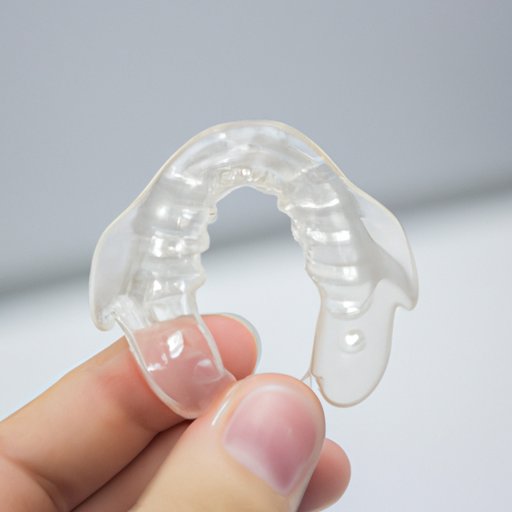Introduction
Retainers are an essential part of orthodontic treatment that can keep your teeth in their new position, but they require routine cleaning to maintain good oral hygiene. Not cleaning your retainer regularly can lead to plaque buildup, bad breath, and even serious oral health problems. In this article, we’ll share some effective tips and methods for keeping your retainer clean and hygienic.
Method #1: Step-by-Step Guide
The process of cleaning your retainer involves removing it from your mouth and cleaning it thoroughly with a suitable cleaning product. To clean your retainer, begin by removing any leftover bits of food or debris by rinsing it under cold water. Using a soft-bristled toothbrush and non-abrasive toothpaste, scrub your retainer gently and rinse it with cold water again. There are also special cleaning products available at drug stores and online, designed specifically to clean retainers.
You should avoid using hot water, as it can damage the retainer and make it less effective. Hot water can also cause warping, which may alter the fit of the retainer and make it less effective.
The ideal time to clean your retainer is when you’re brushing your teeth, so it becomes part of your oral hygiene routine. This will also prevent you from forgetting to clean your retainer regularly.
Method #2: Comparison of Different Cleaning Methods
There are several ways to clean your retainer, such as using specialized cleaning products, dish soap, or warm water and a toothbrush. The most effective cleaning methods, however, include using products specifically designed for cleaning retainers. There are also ultrasonic cleaners that utilize high-frequency sound waves to remove bacteria and buildup.
For those looking for a cheaper, more natural alternative, dish soap can be helpful but it may not clean as thoroughly. Warm water and a toothbrush are also be an option but this method may not be as effective as using specialized cleaning products.
Ultimately, it’s crucial to consider the material of your retainer and the safety of the cleaning solution you use to avoid damaging your appliance.
Method #3: Common Mistakes to Avoid
One of the most common mistakes people make when cleaning their retainers is using hot water. Hot water can cause warping or damage the material of the retainer. Leaving your retainer to air dry is another common mistake because this creates a moist environment where bacteria can thrive. To avoid these mistakes, ensure that you follow the recommended cleaning instructions, avoid the use of hot water, and use a clean, dry towel to dry your retainer.
Method #4: Natural Cleaning Solutions
In addition to the various cleaning products available, natural cleaning solutions, such as vinegar, baking soda, and essential oils can still be effective in cleaning your retainer. A simple recipe of white vinegar mixed with equal parts water has acidic properties that can effectively disinfect your retainer. A paste of baking soda and water rubbed gently on your retainer can remove tough stains. Essential oils, such as tea tree and peppermint oils, can be used to fight bacteria. Remember to always consult with your dental professional before trying any natural cleaning solutions on your retainer.
Method #5: Video Tutorial
Watch this short video tutorial below for a visual depiction of the best way to clean your retainer:
Method #6: Q&A with a Dental Professional
We sat down with Dr. John, a dental professional, to discuss the best practices for cleaning retainers. Read on for his expert advice:
Q: Why is it important to clean your retainer regularly?
A: Cleaning your retainer regularly helps to prevent the buildup of bacteria that can cause bad breath and gum disease. It’s also important because bacteria can cause your retainer to taste or smell bad.
Q: What are the most effective ways to clean a retainer?
A: The most effective way to clean a retainer is to use a specialized retainer cleaner or soak it in vinegar. However, using a soft-bristled toothbrush and non-abrasive toothpaste also work well.
Q: Are there any cleaning mistakes you see often that could be avoided?
A: Yes, some common mistakes include using hot water to clean your retainer, leaving it to air-dry, and using abrasive toothpaste to clean it. These can all damage your retainer and cause it to function less effectively.
Q: What should you avoid doing when cleaning your retainer?
A: You should avoid using abrasive toothpaste or cleaning your retainer in hot water. You should also avoid leaving it to air-dry because this creates a moist environment in which harmful bacteria can grow.
Method #7: Dos and Don’ts
To effectively clean your retainer, follow these dos and don’ts:
- Do use a specialized retainer cleaner or follow your orthodontist’s recommended instructions
- Do brush your retainer regularly using a soft-bristled brush and non-abrasive toothpaste
- Do soak your retainer in water and vinegar for added deep cleaning
- Don’t use hot water to clean or soak your retainer
- Don’t leave your retainer to air-dry
- Don’t use abrasive toothpaste as it can scratch the surface of your retainer
Conclusion
Your retainer is a vital part of maintaining healthy teeth and gums, but regular cleaning is required to maintain its effectiveness. Remember to follow the recommended cleaning instructions from your dental professional and use the most effective cleaning methods to keep your retainer clean and hygienic. With these tips and methods, you can enjoy a cleaner, more effective retainer for years to come.
